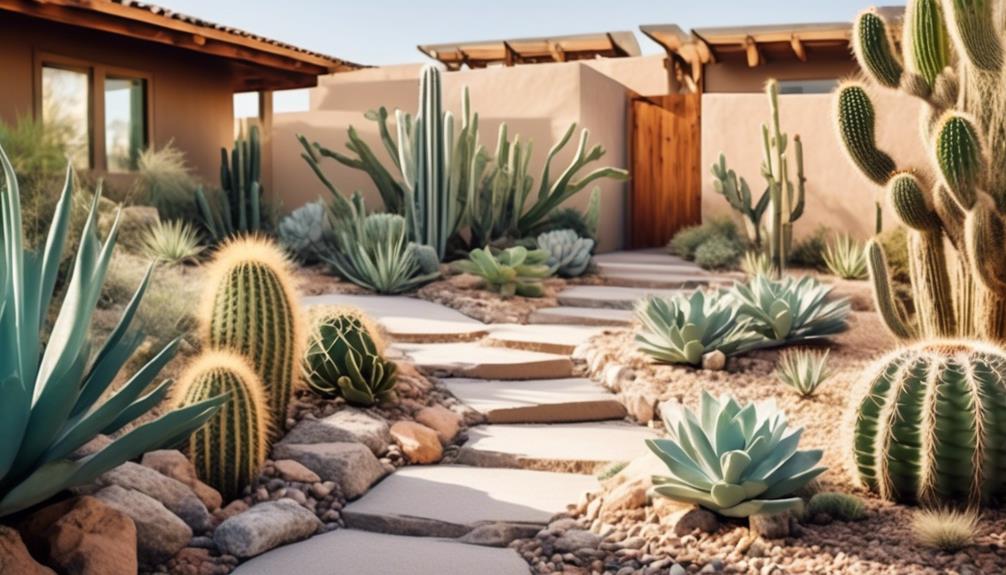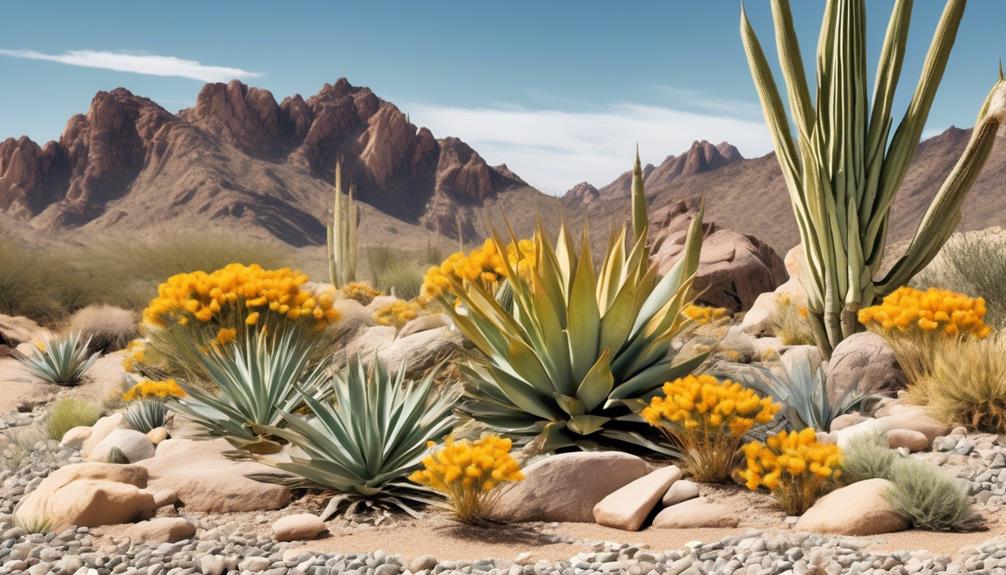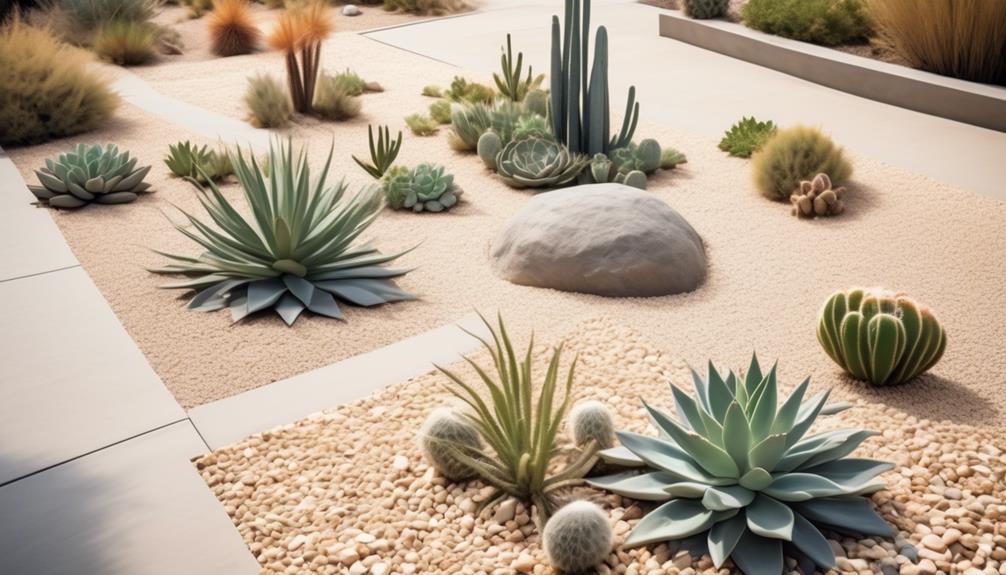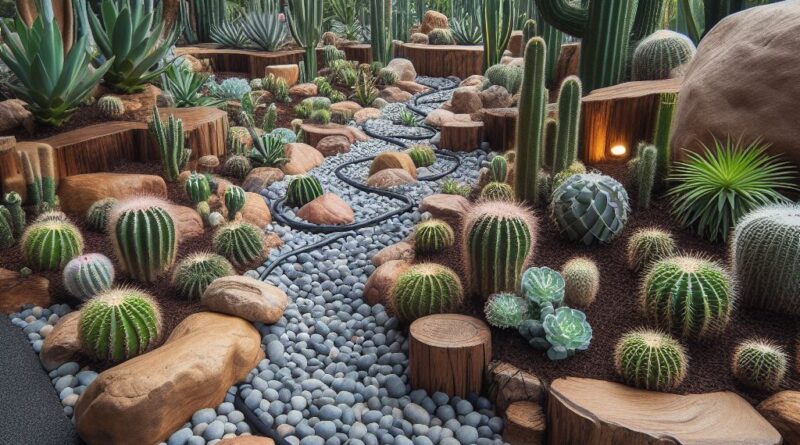5 Drought-Resistant Landscaping Ideas for Arid Climates
This post may contain affiliate links which means I may receive a commission for purchases made through links. As an Amazon Associate, I earn from qualifying purchases. Learn more on my Private Policy page.
You may have heard about the challenges of maintaining a lush, green landscape in arid climates. But what if there were ways to create a stunning outdoor space while conserving water and reducing maintenance?
In this discussion, we’ll explore five practical and aesthetically pleasing drought-resistant landscaping ideas that can thrive in dry, desert-like conditions. These ideas not only offer a solution to the water scarcity problem but also bring unique charm to your outdoor environment.
Xeriscaping

If you’re looking to create a low-maintenance and water-efficient landscape, xeriscaping is the perfect solution. Xeriscaping, which originated in arid regions, is a landscaping technique designed to reduce the need for supplemental watering. This approach emphasizes the use of native plants, drought-resistant species, and efficient irrigation methods to create a sustainable and visually appealing outdoor space.
One of the key principles of xeriscaping is the careful selection of plants that are well-adapted to the local climate and soil conditions. By choosing native and drought-tolerant plants, you can significantly minimize the need for irrigation while still enjoying a vibrant and diverse landscape. These plants often require less water and maintenance, making them ideal for homeowners looking to conserve water and reduce landscaping efforts.
In addition to plant selection, xeriscaping also focuses on efficient irrigation techniques to maximize water conservation. Drip irrigation, soaker hoses, and other water-efficient methods are commonly used in xeriscapes to deliver water directly to the root zones of plants, minimizing water loss due to evaporation and runoff. By implementing these strategies, you can significantly reduce water consumption while promoting healthy plant growth.
Furthermore, xeriscaping often incorporates hardscaping elements such as gravel pathways, mulched areas, and strategically placed rocks to minimize the extent of traditional turf grass lawns. This not only reduces the overall water demand but also decreases the need for mowing and maintenance, contributing to a more sustainable and environmentally friendly landscape.
Succulent Gardens
To continue cultivating a water-efficient landscape, consider incorporating succulent gardens as a way to further reduce water consumption and maintenance efforts. Succulents are an excellent choice for arid climates due to their ability to store water in their leaves and stems, making them highly drought-tolerant. By introducing a variety of succulents such as aloe, agave, and sedum to your garden, you can create a visually appealing and sustainable landscape.
Succulent gardens offer a diverse range of shapes, colors, and textures, allowing you to design a unique and low-maintenance outdoor space. These plants thrive in well-draining soil and require minimal watering, making them an ideal choice for regions with limited water resources. In addition to their water-saving benefits, succulents are relatively pest-resistant and can withstand high temperatures, making them well-suited for hot and dry climates.
When establishing a succulent garden, it’s important to select species that are native to your specific region, as they’re more likely to thrive in local environmental conditions. Proper placement and spacing of succulents are crucial for their growth and overall appearance, so be mindful of their sunlight and space requirements.
Native Plants

Consider incorporating native plants into your landscape to enhance biodiversity and support the local ecosystem.
Native plants are well-adapted to the specific climate, soil, and environmental conditions of your region, making them naturally resilient and low-maintenance.
By choosing native plants for your landscaping, you can reduce water usage, minimize the need for chemical inputs, and create a habitat that attracts local wildlife.
When selecting native plants for your landscape, consider factors such as sunlight, soil type, and available water. Native grasses, wildflowers, shrubs, and trees can add beauty and functionality to your outdoor space. They also play a crucial role in preserving the natural balance of your local environment.
Native plants often have deep root systems that help prevent soil erosion and improve water retention, making them essential for sustainable landscaping in arid climates.
Incorporating native plants also helps to conserve water resources and reduce the impact of landscaping on the environment. Since native plants have evolved to thrive in your local climate, they generally require less water once established. This can significantly lower your outdoor water consumption, especially in regions prone to droughts or water restrictions.
Furthermore, native plants provide food and habitat for local wildlife, including birds, butterflies, and pollinators. By choosing native species, you can create a biodiverse and ecologically valuable landscape that supports the overall health of the ecosystem.
Drip Irrigation
You can optimize water usage in your landscape by implementing a drip irrigation system, delivering water directly to the roots of plants. Drip irrigation is a highly efficient method that reduces water waste and helps plants thrive in arid climates. By using a network of tubing and emitters, this system delivers small amounts of water slowly and consistently, minimizing evaporation and runoff.
One of the key advantages of drip irrigation is its ability to target the root zone of plants, ensuring that water is delivered exactly where it’s needed. This promotes healthy root development and minimizes weed growth since the areas between plants remain dry. Additionally, this method helps prevent foliage diseases by keeping the leaves dry, as the water is applied directly to the soil.
Installing a drip irrigation system allows you to customize watering schedules based on the specific water needs of different plant species. This level of precision not only conserves water but also promotes a more sustainable and resilient landscape. It’s a cost-effective solution that can be easily automated with timers, ensuring that your plants receive consistent and adequate hydration without the need for constant manual intervention.
Furthermore, drip irrigation systems can be integrated with smart technologies that adjust watering based on weather conditions, soil moisture levels, and plant requirements. This level of control and efficiency makes drip irrigation a valuable tool for maintaining a thriving landscape in arid climates while minimizing water consumption.
Hardscaping

By incorporating hardscaping elements into your landscape, such as pathways and retaining walls, you can further enhance the efficiency and visual appeal of your drought-resistant design. Hardscaping not only adds structure and organization to your outdoor space but also plays a crucial role in water conservation and sustainability in arid climates.
When designing pathways, consider using materials like gravel or permeable pavers that allow rainwater to seep into the ground, reducing runoff and erosion. These materials also minimize the need for additional watering, contributing to the overall water efficiency of your landscape.
Retaining walls are another essential hardscaping feature that can help manage water usage in drought-prone areas. By strategically placing retaining walls, you can create terraced levels in your landscape, preventing soil erosion and water runoff. This design not only adds visual interest but also provides opportunities for planting drought-resistant vegetation in each terrace, making the most of available water resources.
In addition to their water conservation benefits, hardscaping elements like pathways and retaining walls contribute to the overall aesthetics of your outdoor space. They define different areas of your landscape, creating a cohesive and organized environment. Furthermore, well-designed hardscaping can reduce the amount of turf or other water-dependent plants, further decreasing the need for irrigation.
When planning your drought-resistant landscaping, integrating hardscaping elements should be a key consideration for both practical and visual enhancements.
Conclusion
In conclusion, creating a drought-resistant landscape in arid climates doesn’t have to be difficult. By incorporating xeriscaping, succulent gardens, native plants, drip irrigation, and hardscaping, you can conserve water and still have a beautiful outdoor space.
With these ideas, you can enjoy a low-maintenance and sustainable landscape that thrives in even the driest of conditions.
